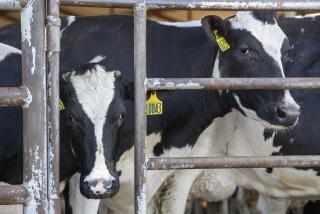U.S.-made tainted feed is recalled
Food safety officials Wednesday announced a recall of U.S.-made animal and fish feed products that contained melamine, the chemical linked to sickness and death in thousands of pets.
The Food and Drug Administration said the risks to human health were âvery smallâ from eating cattle, sheep, goats, fish or shrimp that might have ingested feed produced by Tembec BTLSR Inc. of Toledo, Ohio, and Uniscope Inc. of Johnstown, Colo.
Both companies have voluntarily recalled the products. They were the first U.S. companies found to have melamine in their feed.
Earlier cases of melamine contamination had been linked to ingredients imported from China.
FDA officials said they had not yet determined how many farms or fisheries had received the contaminated feed. The brands include AquaBond and Aqua-Tec II, which Tembec made and distributed for Uniscope, and Uniscopeâs Xtra-Bond, made with ingredients supplied by Tembec.
Tembec, which supplied Uniscope with the ingredient that contained melamine, said it reformulated its product in April after hearing news of the problems associated with the chemical.
But a Tembec executive said the company believed before then that its product, which used melamine to improve binding properties, was safe.
âWe assumed we were producing a compliant product for the applications and the markets into which it was going,â said John Valley, an executive vice president for the Toledo subsidiaryâs parent company, Tembec Inc. of Quebec, Canada.
The FDA said Wednesday that melamine had not been approved for any use in animal feed or human food.
Uniscope, which produces binders that animal and fish feed manufacturers use to make food pellets, has used Tembec resins since 2004, a spokesman for the company said.
But the company decided to have its raw ingredients tested in May, after months of news about contaminated Chinese ingredients that were used to make pet and animal feeds.
Those tests came back positive for melamine, which the company reported to the FDA on May 18.
âWe donât know how much or for how long the Tembec product included melamine,â Uniscope spokesman Charles Russell said. âAll we can say is that the samples we tested in May 2007 contained a small concentration of melamine.â
The melamine tainting problem with dog and cat food was discovered in March, when pet food manufacturer Menu Foods Income Fund of Ontario, Canada, recalled more than 60 million containers of dog and cat food after receiving reports of sick and dying animals.
The FDA said that the food contained ingredients tainted with melamine, used in making plastic, and cyanuric acid, a melamine byproduct used to sanitize pool water, and that the interaction between the chemicals probably caused renal failure in the animals.
Those chemicals, which are high in nitrogen, might have been added to make the food ingredients appear protein-rich, since a common protein test evaluates nitrogen content.
Some tainted pet food, which was sold under popular brand names including Iams and Hills Pet Nutrition, also was sold to animal feed manufacturers who used the tainted product to produce feed for poultry, hogs and fish.
In all, more than 150 brands and more than 5,000 products have been affected by the earlier recall. Millions of chickens, 56,000 swine and an undetermined number of fish may have eaten tainted feed.
But those cases stemmed from the import of adulterated wheat flour from China, which was improperly labeled and sold as wheat gluten and rice protein concentrate.
In the problem identified Wednesday, the amount of melamine in the livestock feed was less than 50 parts per million. The fish and shrimp feed contained less than 233 parts per million and 465 parts per million, respectively.
Those amounts are well below levels believed to be dangerous to humans, the FDA said.
*
More to Read
Inside the business of entertainment
The Wide Shot brings you news, analysis and insights on everything from streaming wars to production â and what it all means for the future.
You may occasionally receive promotional content from the Los Angeles Times.









